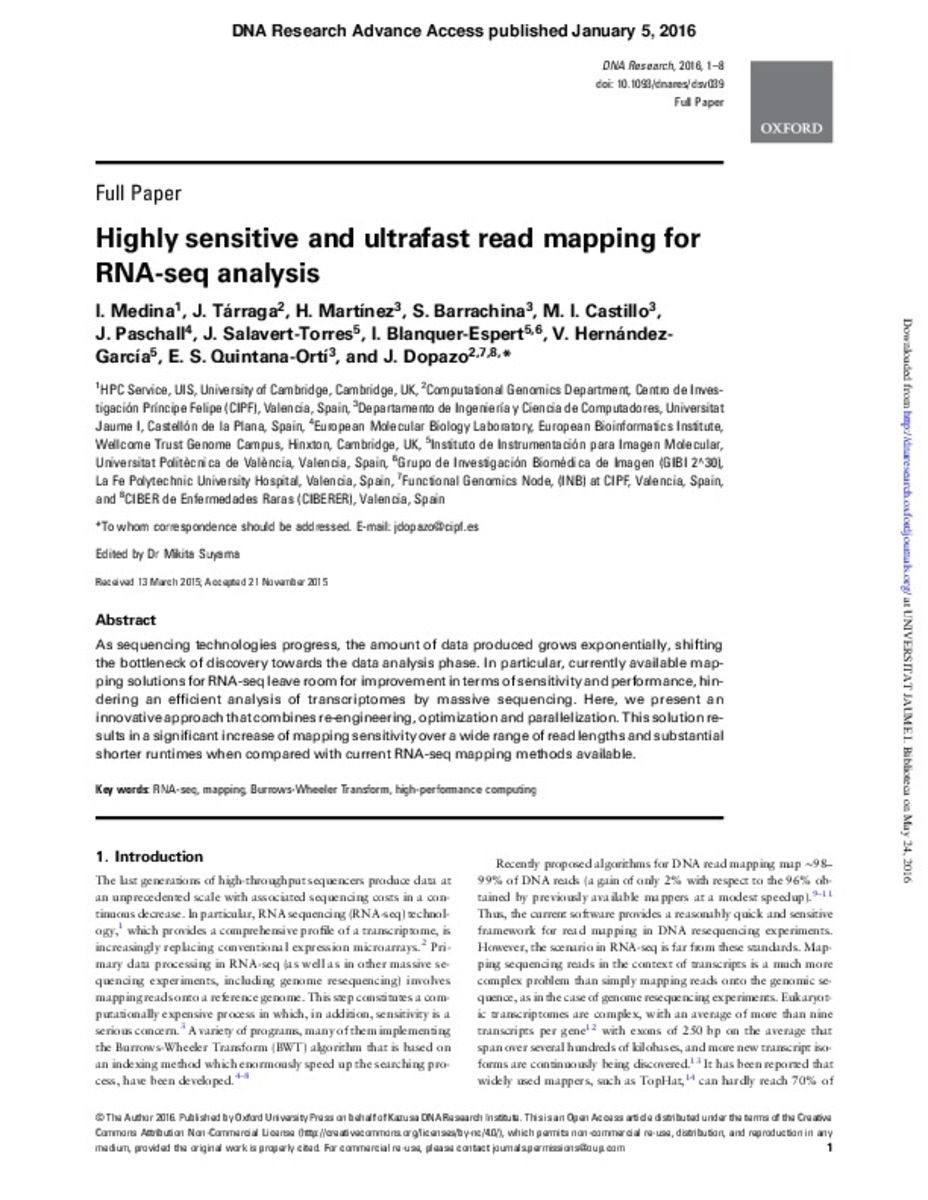Mostrar el registro sencillo del ítem
Highly sensitive and ultrafast read mapping for RNA-seq analysis
| dc.contributor.author | Barrachina Mir, Sergio | |
| dc.contributor.author | Castillo Catalán, María Isabel | |
| dc.contributor.author | Martínez Pérez, Héctor | |
| dc.contributor.author | Medina, Ignacio | |
| dc.contributor.author | Tárraga, Joaquín | |
| dc.contributor.author | Quintana-Orti, Enrique S. | |
| dc.contributor.author | Dopazo, Joaquín | |
| dc.contributor.author | Salavert Torres, José | |
| dc.contributor.author | Blanquer Espert, Ignacio | |
| dc.contributor.author | Paschall, J. | |
| dc.contributor.author | Hernández-García, V. | |
| dc.date.accessioned | 2016-05-24T09:28:06Z | |
| dc.date.available | 2016-05-24T09:28:06Z | |
| dc.date.issued | 2016 | |
| dc.identifier.citation | I. Medina, J. Tárraga, H. Martínez, S. Barrachina, M. I. Castillo, J. Paschall, J. Salavert-Torres, I. Blanquer-Espert, V. Hernández-García, E. S. Quintana-Ortí, and J. Dopazo. Highly sensitive and ultrafast read mapping for RNA-seq analysis DNA Res first published online January 5, 2016 doi:10.1093/dnares/dsv039 | ca_CA |
| dc.identifier.issn | 1340-2838 | |
| dc.identifier.issn | 1756-1663 | |
| dc.identifier.uri | http://hdl.handle.net/10234/159928 | |
| dc.description.abstract | As sequencing technologies progress, the amount of data produced grows exponentially, shifting the bottleneck of discovery towards the data analysis phase. In particular, currently available mapping solutions for RNA-seq leave room for improvement in terms of sensitivity and performance, hindering an efficient analysis of transcriptomes by massive sequencing. Here, we present an innovative approach that combines re-engineering, optimization and parallelization. This solution results in a significant increase of mapping sensitivity over a wide range of read lengths and substantial shorter runtimes when compared with current RNA-seq mapping methods available. | ca_CA |
| dc.description.sponsorShip | This work is supported by grants from the Spanish Ministry of Economy and Competitiveness (BIO2014-57291-R) and co-funded with European Regional Development Funds (ERDF), AECID (D/016099/08) and from the Conselleria d’Educacio of the Valencian Community (PROMETEOII/2014/025). This work has been carried out in the context of the HPC4G initiative (http://www.hpc4g.org) and the Bull-CIPF Chair for Computational Genomics. Funding to pay the Open Access publication charges for this article was provided by grant BIO2014-57291-R from the Spanish Ministry of Economy and Competitiveness (MINECO), co-funded with European Regional Development Funds (ERDF). | ca_CA |
| dc.format.extent | 8 p. | ca_CA |
| dc.format.mimetype | application/pdf | ca_CA |
| dc.language.iso | eng | ca_CA |
| dc.publisher | Oxford University Press | ca_CA |
| dc.rights | Attribution-NonCommercial 4.0 Spain | * |
| dc.rights.uri | http://creativecommons.org/licenses/by-nc/4.0/ | * |
| dc.subject | RNA-seq | ca_CA |
| dc.subject | mapping | ca_CA |
| dc.subject | Burrows-Wheeler Transform | ca_CA |
| dc.subject | high-performance computing | ca_CA |
| dc.title | Highly sensitive and ultrafast read mapping for RNA-seq analysis | ca_CA |
| dc.type | info:eu-repo/semantics/article | ca_CA |
| dc.identifier.doi | http://dx.doi.org/10.1093/dnares/dsv039 | |
| dc.rights.accessRights | info:eu-repo/semantics/openAccess | ca_CA |
| dc.relation.publisherVersion | http://dnaresearch.oxfordjournals.org/content/early/2016/01/05/dnares.dsv039.full.pdf+html | ca_CA |
Ficheros en el ítem
Este ítem aparece en la(s) siguiente(s) colección(ones)
-
ICC_Articles [413]








